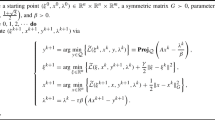Abstract
In this paper a successive optimization method for solving inequality constrained optimization problems is introduced via a parametric monotone composition reformulation. The global optimal value of the original constrained optimization problem is shown to be the least root of the optimal value function of an auxiliary parametric optimization problem, thus can be found via a bisection method. The parametric optimization subproblem is formulated in such a way that it is a one-parameter problem and its value function is a monotone composition function with respect to the original objective function and the constraints. Various forms can be taken in the parametric optimization problem in accordance with a special structure of the original optimization problem, and in some cases, the parametric optimization problems are convex composite ones. Finally, the parametric monotone composite reformulation is applied to study local optimality.
Similar content being viewed by others
References
Avriel, M., Diewert, W.E., Schaible, S. and Zang, I. (1988), Generalized Concavity, Plenum Press, New York and London.
Bank, B., Guddat, J., Klatte, D., Kummer, B. and Tammer, K. (1983), Non-linear Parametric Optimization, Birkhauser Verlag, Basel.
Bazaraa, M.S. and Shetty, C.M. (1979), Nonlinear Programming, John Wiley & Sons, New York, Singapore.
Ben-Tal, A. and Teboulle, M. (1996), Hidden convexity in some nonconvex quadratically constrained quadratic programming, Mathematical Programming 72: 51–63.
Bertsekas, D.P. (1982), Constrained Optimization and Lagrange Multiplier Methods, Academic Press, New York and London.
Fongo, F. (1988), Nonconvex Programming, Academic Press, Budapest.
Goh, C.J. and Yang, X.Q. (1997), A sufficient and necessary condition for nonconvex optimization, Applied Mathematics Letters 10: 9–12.
Goh, C.J. and Yang, X.Q. (1998), Comment on convexification of a nonconvex frontier, Journal of Optimization Theory and Applications 97: 759–768.
Grace, A. (1990), Optimization Toolbox for use with MATLAB user guide, The Maths Works, Inc., South Natick, MA.
Hiriart-Urruty, J.B. and Lemarchal, C. (1993), Convex analysis and minimization algorithms. I, II, Springer-Verlag, Berlin.
Horst, R. (1984), On the convexification of nonlinear programming problems: An application-oriented survey, European Journal of Operations Research 15: 382–392.
Horst, R. and Tuy, H. (1991), Global Optimization–Deterministic Approaches, Springer-Verlag.
Konno, H., Thach, P.T. and Tuy, H. (1997), Optimization on Low Rank Nonconvex Structures, Kluwer Academic Publishers, Dordrecht /Boston/London.
Li, D. (1995), Zero duality gap for a class of nonconvex optimization problem, Journal of Optimization Theory and Applications 85(2): 309–324.
Li, D. (1996), Convexification of a noninferior frontier, Journal of Optimization Theory and Applications 88: 177–196.
Luenberger, D.G. (1989), Linear and Nonlinear Programming, second edition, Addison Wesley, Reading, MA.
Mangasarian, O.L. (1969), Nonlinear Programming, McGraw-Hill, New York.
Nemhauser, G.L. and Wolsey, L.A. (1988), Integer and Combinatorial Optimization, Wiley, New York and Toronto.
Rubinov, A., Glover, B.M. and Yang, X.Q. Decreasing functions with applications to penalization, SIAM Journal on Optimization (to appear).
Rinnoy Kan, A.H.G. and Timmer, G.T. (1987), Stochastic global optimization method, Mathematical Programming 39: 57–78.
Yang, X.Q. (1998), Second order global optimality conditions for convex composite optimization, Mathematical Programming 81: 327–347.
Yang, X.Q. and Goh, C.J. A nonlinear Lagrangian function for discrete optimization problems, in Migdalas, A., Pardalos, A., Varbrand, P. and Holmqvist, K. (eds), From Local to Global Optimization, Kluwer Academic Publishers (to appear).
Author information
Authors and Affiliations
Rights and permissions
About this article
Cite this article
Yang, X., Li, D. Successive Optimization Method via Parametric Monotone Composition Formulation*. Journal of Global Optimization 16, 355–369 (2000). https://doi.org/10.1023/A:1008356305392
Issue Date:
DOI: https://doi.org/10.1023/A:1008356305392




